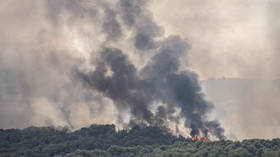Israel approved killing its own soldiers – media

The Israel Defense Forces (IDF) authorized strikes on its own soldiers – and possibly civilians – to prevent them from being taken to Gaza by Hamas militants, according to documents obtained by Haaretz.
The allegations that the command had been issued, initially made months ago by journalist Max Blumenthal, were initially denied outright by West Jerusalem but have resurfaced following reporting from the Israeli outlet.
As Hamas militants raided military bases and settlements across southern Israel on the morning of October 7, the IDF’s Gaza Division and Southern Command relayed the directive “Hannibal at Erez” to a nearby outpost, followed by an order to “dispatch a Zik,” Haaretz reported on Sunday.
This order tasked the outpost with employing the so-called “Hannibal Directive,” a secretive Israeli policy that permits soldiers to take the lives of their comrades in order to prevent their capture. A Zik is an attack drone capable of firing guided missiles at targets below.
The Hannibal Directive was given multiple times at Erez throughout the day, Haaretz reported, and at two other locations: Re’im army base, where the Gaza Division is headquartered, and an outpost near the Nahal Oz Kibbutz, from where around two dozen soldiers and civilians were taken hostage.
By noon, the Gaza Division had received an order from Southern Command, stating that “not a single vehicle can return to Gaza,” a source within the command told Haaretz.
“Everyone knew by then that such vehicles could be carrying kidnapped civilians or soldiers,” the source said. “There was no case in which a vehicle carrying kidnapped people was knowingly attacked, but you couldn’t really know if there were any such people in a vehicle. I can’t say there was a clear instruction, but everyone knew what it meant to not let any vehicles return to Gaza.”
In addition to authorizing the targeting of all Gaza-bound vehicles, the IDF began saturating the border area with mortar fire. “The instruction was meant to turn the area around the border fence into a killing zone, closing it off toward the west,” Haaretz’s source said.
More than 1,100 Israelis were killed on October 7, and around 250 taken to Gaza as hostages. It is unclear if any of the dead were killed by Israeli fire as a result of these directives.
In one case that has already received media attention, 13 hostages were killed when an Israeli tank opened fire on a house at Kibbutz Be’eri, where they were being held by Hamas gunmen. The IDF is investigating the incident, and a final report is expected to determine whether the commander responsible was employing the Hannibal procedure.
Israeli commanders devised the Hannibal Directive after three IDF troops were kidnapped by Lebanese Hezbollah militants in 1986, according to Haaretz reporter Sara Leibovich-Dar. While its details have never been fully explained by the IDF, Israeli newspaper reports suggest that it has been rewritten several times in the years since, and has been communicated to troops as both a strict set of rules concerning the use of fire against kidnappers’ vehicles, and an unofficial policy stating that “a dead soldier is preferable to a captured one.”
The directive’s name was supposedly inspired by the Carthaginian general Hannibal, who poisoned himself to avoid capture by the Romans around 180 BC.















